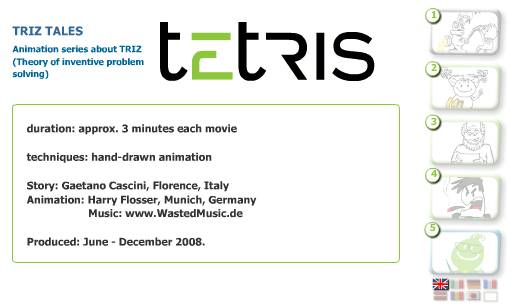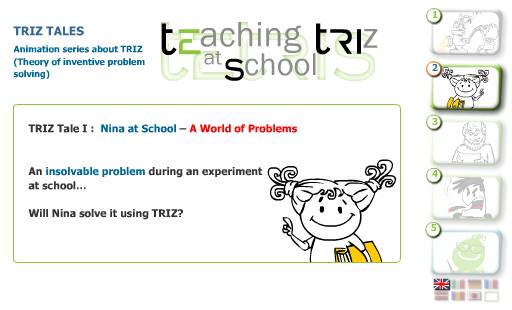 TRIZ Forum: TRIZ Education at Schools TRIZ Forum: TRIZ Education at Schools |

 
|
TRIZ Tales Animation in Japanese:
TETRIS Project for TRIZ Education at Schools |
Original story: Genrich Altshuller
Story: Getano Cascini (Italy)
Pictures: Harry Flosser (Germany)
Japanese translation: Katsuya Miyanishi and Toru Nakagawa
|
| Introduction by Toru Nakagawa |
| Posted on Oct. 12, 2009. Updated: Oct. 27, 2009. |
For going back to Japanese pages, press  buttons.
buttons.
Editor's Note (Toru Nakagawa, Oct. 10, 2009)
Promoting TRIZ at schools for children, kids, and teens in Japan has long been a desire for me. One of such actions in this Web site was the posting of English translation of Russian texts of "CID Course for Children:Course of Creative Imagination Development (CID) based on TRIZ: Methodical Guide-Books and Children Workbooks for Three Grades". 
 A complete series of 6 booklets was originally written and taught in Russian by Natalia V. Rubina (Petrozavodsk, Russia) in 1998-1999, translated into English by Irina Dolina (Tokyo, Japan) in 2000-2001, and technically edited and posted in this Web site by Toru Nakagawa (Osaka Gakuin Univ.) in 2000-2002. The posting started on Jan. 30, 2001 and finished on Feb. 17, 2002. The English texts received about 30 responses from readers of about 10 different countries, many of which suggesting and initiating some work of using them to teach, publishing them, or further translating them into their own languages. All the proposals/trials have faded out without concrete results, unfortunately, and I myself have not been able to make its Japanese Edition yet. --- I still have the hope of making these projects real with your help!!
A complete series of 6 booklets was originally written and taught in Russian by Natalia V. Rubina (Petrozavodsk, Russia) in 1998-1999, translated into English by Irina Dolina (Tokyo, Japan) in 2000-2001, and technically edited and posted in this Web site by Toru Nakagawa (Osaka Gakuin Univ.) in 2000-2002. The posting started on Jan. 30, 2001 and finished on Feb. 17, 2002. The English texts received about 30 responses from readers of about 10 different countries, many of which suggesting and initiating some work of using them to teach, publishing them, or further translating them into their own languages. All the proposals/trials have faded out without concrete results, unfortunately, and I myself have not been able to make its Japanese Edition yet. --- I still have the hope of making these projects real with your help!!
Last year in the Fourth TRIZ Symposium in Japan 2008, Taichiro Miyanishi, a schoolboy of age 13, and his father Katsuya Miyanishi gave a nice presentation with the title of 'Why Water Striders can stand and slide on the Water?: A Summer Homework by Son and Father with TRIZ' 
 . The junior high school boy enjoyed to figure out the secret of the insect by using TRIZ way of thinking. This presentation encouraged much the TRIZ people in Japan, mostly engineers, managers, and university staff. Thus, in the Japan TRIZ Society we have been discussing how to start promoting TRIZ at schools in Japan. The key problems are to find school teachers who are interested in TRIZ and to have chances of trials of teaching at schools.
. The junior high school boy enjoyed to figure out the secret of the insect by using TRIZ way of thinking. This presentation encouraged much the TRIZ people in Japan, mostly engineers, managers, and university staff. Thus, in the Japan TRIZ Society we have been discussing how to start promoting TRIZ at schools in Japan. The key problems are to find school teachers who are interested in TRIZ and to have chances of trials of teaching at schools.
Last June I received an announcement of TETRIS Project saying they have opened a Web site with animations of TRIZ Tales. The project aims at "Teaching TRIZ at School" and is financially supported by the Life Long Learning Programme 2007 – 2013 “Leonardo da Vinci” of European Commision. (See some more below.) The animated stories 'TRIZ Tales' were written by Gaetano Cascini (Italy) on the basis of Genrich Altshuller's book "And Suddenly the Inventor Appeared", and the picture animation was made by Harry Flosser (Germany). (See below.)
In early July I received an unexpected message from Harry Flosser, asking me if I am interested in translating the animation into Japanese. I immediately sent an email to Katsuya Miyanishi for his help. Thus we started the translation project quickly. Toshihiro Hayashi (President of the Japan TRIZ Society) and Rikie Ishii gave us much encouragement for this project. In late July, Katsuya Miyanishi made a nice draft in colloquial Japanese language which matches well with the pictures. After brushing it up, Nakagawa sent it back to the TETRIS Project. Harry Flosser installed the Japanese texts in his animation files and made them publicly available, just before our TRIZ Symposium in Japan.
The animated TRIZ Tales in Japanese are now publicly accessible in the TETRIS Project Web site (http://www.tetris-project.org/). Go to the TETRIS Project, choose the 'TRIZ animations' tab in the Hot Spots, and then click the banner of Japanese language.
For your easier reference and for wider penetration of the site, I quoted several scenes of the animation below, under the permission by the TETRIS Project (Note: in English in this page and in Japanese in the Japanese page). We are also planning to show PDF files of the slides in the form of 'Japanese Anime' (or 'Manga' in Japanese), for the sake of smaller size and easier reading.
We wish to express our thanks to Harry Flosser, Gaetano Cascini, and the TETRIS project for giving us the chance of cooperation and for making this nice TRIZ animation accessible for people in Japan and in the World. We also wish that the present work encourage people involved in TRIZ or in teaching to promote teaching creative ways of thinking at school.
[Note: T. Nakagawa, Oct. 27, 2009: By courtesy of Harry Flosser, the Japanese version of the animation is now accessible more smoothly through our new Japanese page  .]
.]
 TETRIS Project: Teaching TRIZ at School
TETRIS Project: Teaching TRIZ at School
TETRIS Project Web site: http://www.tetris-project.org/
TETRIS - TEaching TRIz at School - is a project with the financial support of the Life Long Learning Programme 2007 – 2013 “Leonardo da Vinci” (of European Commission).
TETRIS Project was reported at ETRIA TFC 2008, Nov. 2008, by the following paper:
"TETRIS: Teaching TRIZ at School: Meeting the Educational Requirements of Heterogeneous Curricula"
G. Cascini (University of Florence, Italy), J. Jantschgi (Carinthian University of Applied Sciences, Austria), I. Kaikov (European Institute for Energy Research, Germany), N. Khomenko (University of Florence, Italy), I. Murashkovska, A. Sokol (Jelgava Regional Adult Education Centre, Latvia), F. Tomasi (AREA Science Park, Italy).
Abstract: Enhanced creativity, problem setting and problem solving skills are missing topics in most of secondary schools of the European countries. Besides, actual TRIZ courses, seminars and educational materials are mostly tailored for industry or technical universities while they fail to meet the requirements of many different potential readers and learners from general upper-secondary school students and teachers to people interested in human science disciplines. The TETRIS project, funded by the European Community within the Lifelong Learning Programme, aims at producing and testing TRIZ educational material suitable for learners from 14 years old onwards following any kind of curriculum. The paper presents the goal and the structure of the project, dedicating a proper attention to the description of the identified educational requirements and to the approach followed to build the Body of Knowledge of the educational material.
The paper was introduced and reviewed in Nakagawa's 'Personal Report of ETRIA TFC 2008' posted in "TRIZ Home Page in Japan" 
 . (Mar. 2, 2009). My comment at the end of the review is quoted here:
. (Mar. 2, 2009). My comment at the end of the review is quoted here:
*** I missed to attend at the session of this presentation, and do not know what kind of discussions were made in the session. However, I would prefer a much wider standpoint in teaching TRIZ, or rather the subject area related to TRIZ. Teaching (a) in industries, (b) in universities, and (c) in high schools are much different from one another, I suppose. Even in industries, people want to master not TRIZ but an effective problem solving method. In universities, students want to study (or we teachers want for students to study) slightly wider area such as methodologies of analyzing and solving technical (and other) problems and systematic innovation, not limited to TRIZ (needless to say, not limited to Classical TRIZ). And in high schools, students want to learn systematic ways of observing, understanding, and solving various problems and creative ways of thinking. In this sense, I feel that the TETRIS Body of Knowledge should cover much wider range than the present one, which seems to be a subset of (Classical) TRIZ Body of Knowledge. -- My experiences of teaching undergraduate students at Osaka Gakuin University (and also industrial engineers) were presented at ETRIA TFC 2007 and posted in my Web site 
 .
.
 TRIZ Tales Animation in the TETRIS Project
TRIZ Tales Animation in the TETRIS Project
By clicking the 'TRIZ animations' button in the top page of the TETRIS Project Web site, you see the following figure:

As you see at the bottom-right, the texts in the animation are now available in 7 languages, i.e., English, French, Italian, German, Latvian, Rumanian, and Japanese. Selecting your preferable language and placing the pointer at any of the 5 movie slides, you will see the title description such as:

The animation is quite attractive with the scenes like:






The 5 animations are: (1) History of TRIZ, (2) Nina at School, (3) Nina at University, (4) Nina at Work, and (5) Evolution.
 Japanese Version of the TRIZ Tales Animation
Japanese Version of the TRIZ Tales Animation
Original story by Genrich Altshuller
Story by Gaetano Cascini (Polytechnic University of Milan, Italy)
Pictures by Harry Flosser (Harry Flosser Studio, Munich, Germany)
Music by Wasted Music
Japanese translation by Katsuya Miyanishi and Toru Nakagawa
The animated movies with the texts in Japanese are available in the Web site of the TETRIS Project.
http://www.tetris-project.org/
Note: T. Nakagawa, Oct. 27, 2009: By courtesy of Harry Flosser, the Japanese version of the animation is now accessible more smoothly through our new Japanese page  . Jump into the Japanese page, and just click the picture of Nina
. Jump into the Japanese page, and just click the picture of Nina  .
.
Last updated on Oct. 27, 2009. Access point: Editor: nakagawa@ogu.ac.jp